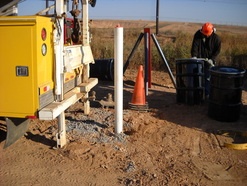Do you need a permit to drill a groundwater monitoring well located in a groundwater conservation district? The answer is yes. You will need a permit to drill a groundwater monitoring well in certain Groundwater Conservation Districts. The State of Texas has established local groundwater conservation districts. They focus on managing and protecting groundwater resources in their given area. As part of their duties, they create management plans, adopt rules, keep records, and permit wells, including water and monitoring wells. Around Amarillo, for example, the Panhandle Groundwater District is the agency in charge of managing groundwater resources.
How Do You Apply for the Permit?
Applying for a permit is pretty simple. The person or entity pulling the permit needs to provide information on the property and well:
- Property owner name/address
- Location of the property
- Property location and description
- Intended use (aquifer depth monitoring or water quality monitoring)
- Basic information about drilling (casing width, project date start, drilling company info, well log, etc.)
- The exact location of the proposed well on the property (distance from property lines, latitude/longitude, surface elevation)
- This information lets the district check that the well meets district regulations. It also allows them to plot the well on the district map.
The time it takes to get a permit depends on the size of the property and how many monitoring wells the project warrants. A single well permit takes about a week in most cases. Multiple wells have special requirements, which can push out the permitting processing time.
What Do You Need To Do Once The Drilling Project Is Completed?
Upon completion of the drilling project, the completed drilling log must come back to the District. That provides proof of the project's completion.
By taking out the permit and completing the project, the property owner agrees to provide the District with semi-annual reports on water analysis and depth to aquifer. The property owner also agrees to provide copies of any other sampling done. This allows the District to monitor water quality and aquifer depth from wells throughout the district. The property owner is also agreeing that the District can inspect and test the well at reasonable times. If the well is ever closed, the property owner is also agreeing to properly plug and abandon the groundwater monitoring well and register its closure with the District.
Environmental drilling is a common need throughout Texas, New Mexico, Kansas and Oklahoma. Testing aquifer depths and quality is essential for preserving the precious water resources in the state. If you need a company to install a groundwater monitoring well on your property, call Talon/LPE today.

